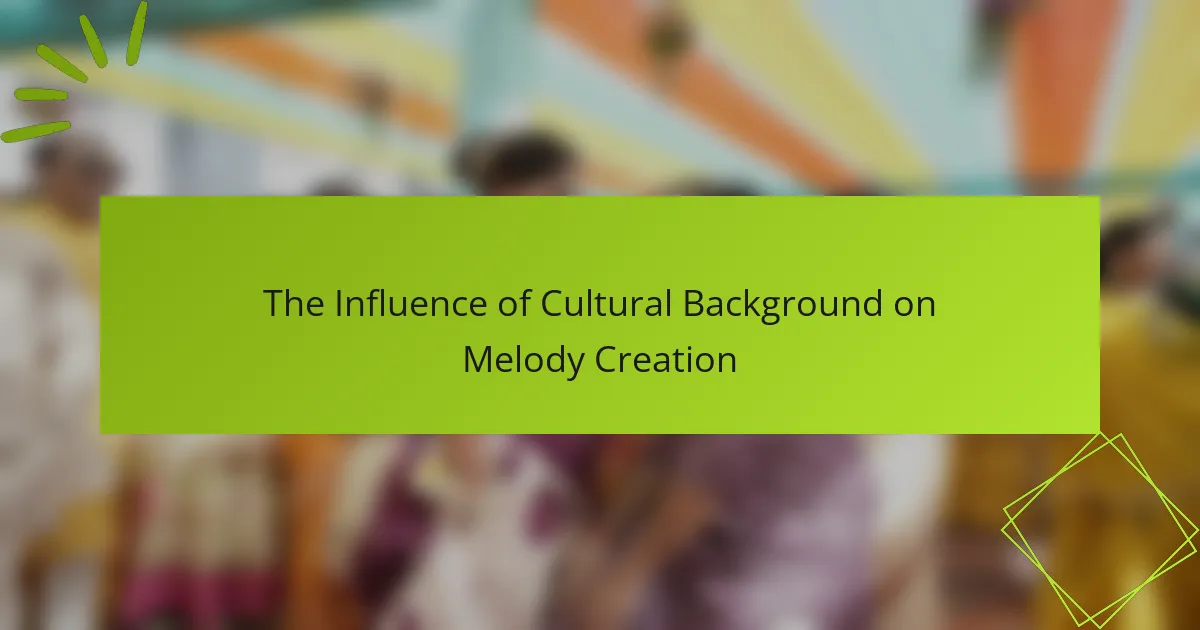The influence of cultural background on melody creation is profound, as it dictates the selection of notes, rhythms, and emotional nuances in music. Elements such as language, religious beliefs, and social customs play a crucial role in shaping how melodies are structured and perceived across various cultures. By incorporating these cultural elements, musicians can enrich their compositions, creating authentic sounds that resonate with diverse audiences and foster deeper connections through shared experiences.
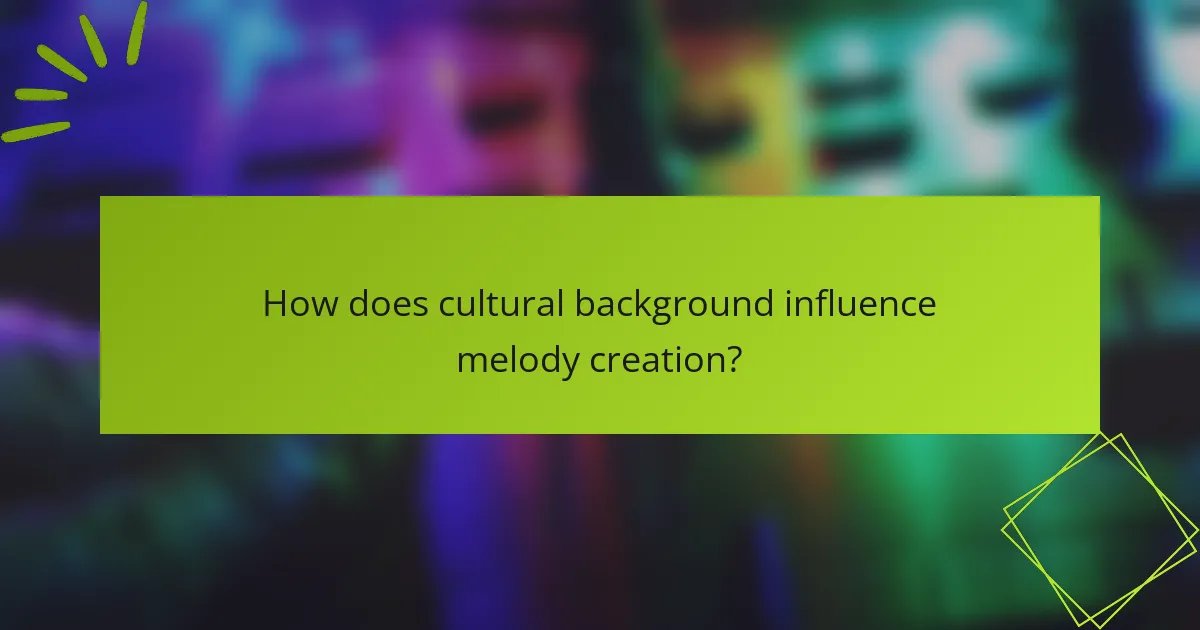
How does cultural background influence melody creation?
Cultural background significantly shapes melody creation by affecting the choice of notes, rhythms, and emotional expressions. Different cultures bring unique musical elements that influence how melodies are constructed and perceived.
Impact of cultural instruments
The instruments prevalent in a culture play a crucial role in melody creation. For example, string instruments like the sitar in Indian music produce distinct tonal qualities that influence melodic lines, while wind instruments like the shakuhachi in Japanese music offer different expressive capabilities. These instruments not only dictate the sound but also the techniques used in melody crafting.
Musicians often adapt their melodies to suit the characteristics of their traditional instruments, leading to unique styles that reflect cultural heritage. Understanding the specific instruments of a culture can provide insight into its melodic structures.
Variations in scales and modes
Cultural backgrounds lead to the use of different scales and modes, which fundamentally alter melody creation. Western music typically utilizes major and minor scales, while many Middle Eastern and Asian traditions employ microtonal scales, resulting in varied melodic intervals. This diversity affects how melodies are constructed and perceived across cultures.
For instance, the use of the pentatonic scale is common in East Asian music, creating a distinct sound that differs from the diatonic scales prevalent in Western compositions. Composers should consider these variations when exploring melodies from different cultural contexts.
Influence of folk traditions
Folk traditions significantly influence melody creation by embedding cultural narratives and emotions into music. Traditional songs often carry historical significance and reflect the values and experiences of a community. This connection to cultural identity shapes the melodies that are passed down through generations.
When creating melodies inspired by folk traditions, musicians can draw from specific rhythmic patterns, lyrical themes, and melodic contours that are characteristic of their cultural background. Engaging with these elements can enhance authenticity and emotional resonance in new compositions.
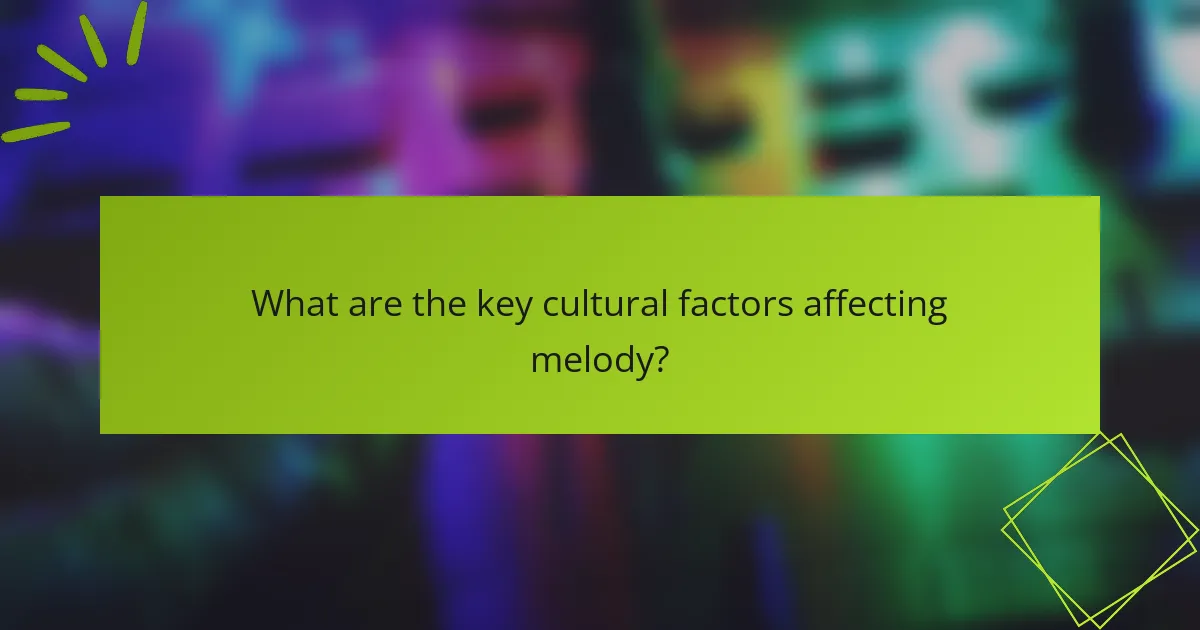
What are the key cultural factors affecting melody?
Cultural background significantly influences melody creation through various factors such as language, religious beliefs, and social customs. These elements shape how melodies are structured, perceived, and performed across different cultures.
Language and phonetics
The sounds and structures of a language can greatly impact melody. For example, tonal languages like Mandarin use pitch to distinguish meaning, leading to melodies that reflect these tonal variations. In contrast, non-tonal languages may favor different melodic patterns that align with their phonetic characteristics.
Additionally, the syllable structure of a language can dictate rhythmic patterns in melody. Languages with many open syllables may produce more flowing melodies, while those with complex consonant clusters might create more staccato or fragmented musical phrases.
Religious and spiritual influences
Religious beliefs often dictate the themes and structures of melodies within a culture. For instance, Gregorian chants in Christianity emphasize modal scales and a monophonic texture, reflecting the spiritual intent of worship. Similarly, Islamic music often avoids certain harmonic structures to align with religious principles, focusing instead on intricate melodic lines.
Moreover, rituals and ceremonies can shape the creation of melodies. Traditional songs used in weddings, funerals, or festivals often incorporate specific melodic elements that resonate with cultural significance, enhancing the emotional experience of the event.

How can musicians leverage cultural backgrounds in their work?
Musicians can enhance their compositions by integrating elements from their cultural backgrounds, which can add depth and authenticity to their music. This approach not only enriches their sound but also resonates with diverse audiences, fostering a deeper connection through shared cultural experiences.
Incorporating traditional elements
Incorporating traditional elements involves using instruments, scales, and rhythms that are characteristic of a specific culture. For example, a musician might blend the pentatonic scale common in Asian music with Western harmonies to create a unique sound. This fusion can make the music more relatable to listeners familiar with those traditions.
When integrating traditional elements, consider the context and significance of each component. Ensure that the use of cultural motifs is respectful and informed, avoiding stereotypes or superficial representations. Engaging with cultural experts or communities can provide valuable insights and authenticity.
Collaborating with diverse artists
Collaborating with artists from different cultural backgrounds can lead to innovative musical creations. By working together, musicians can share techniques, instruments, and perspectives, resulting in a richer sonic palette. For instance, a Western pop artist might collaborate with a traditional folk musician to create a cross-genre hit that appeals to a broader audience.
To maximize the benefits of collaboration, establish clear communication and mutual respect among artists. Be open to experimenting with new styles and ideas, but also set boundaries to maintain each artist’s integrity. This approach can help avoid cultural appropriation and foster genuine artistic exchange.
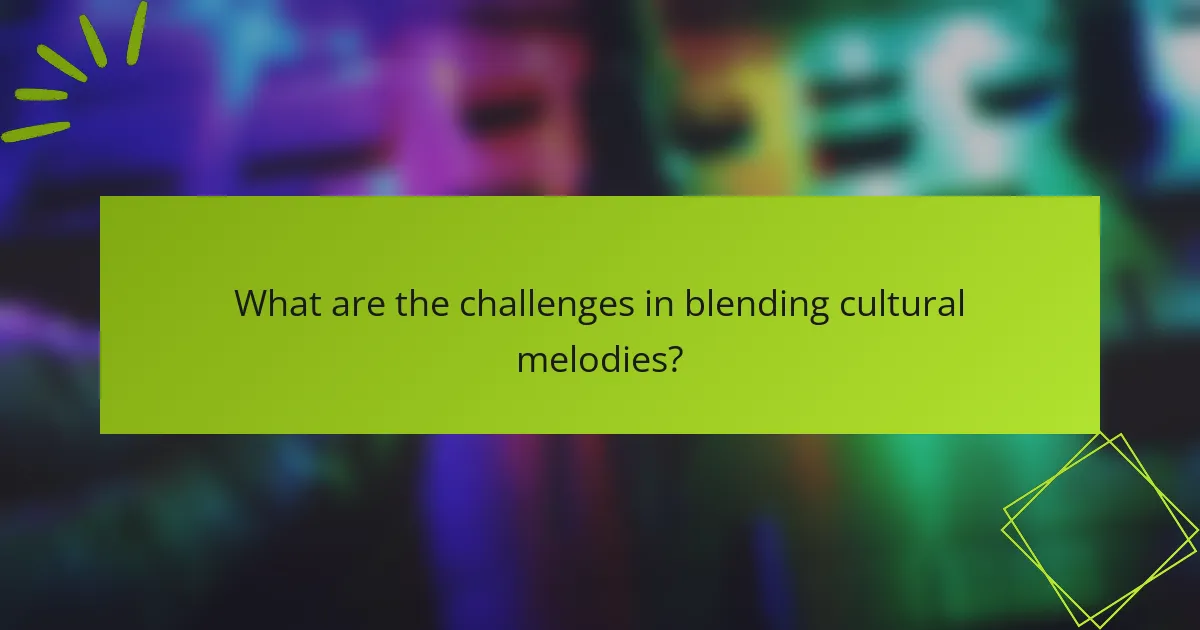
What are the challenges in blending cultural melodies?
Blending cultural melodies presents challenges such as misinterpretation of cultural elements and the need to balance authenticity with innovation. These factors can significantly impact the effectiveness and reception of the resulting musical compositions.
Misinterpretation of cultural elements
Misinterpretation occurs when musicians fail to grasp the significance of specific cultural motifs, rhythms, or scales. This can lead to the dilution of the original meaning or emotional impact of the melody. For example, using a traditional scale from one culture in a way that is not respectful or true to its origins can alienate listeners.
To avoid misinterpretation, it is essential to conduct thorough research and engage with cultural experts or community members. Understanding the historical context and emotional resonance of the elements being used can help ensure that the music is both respectful and authentic.
Balancing authenticity and innovation
Balancing authenticity and innovation is crucial when creating music that blends different cultural melodies. Musicians must decide how much of the original cultural sound to retain while incorporating new ideas. Striking this balance can be challenging, as too much innovation may lead to a loss of cultural identity, while excessive adherence to tradition can stifle creativity.
A practical approach is to experiment with different combinations of traditional and contemporary elements, allowing for a dialogue between the two. For instance, incorporating modern instruments while maintaining traditional rhythms can create a fresh sound that respects its roots. Regular feedback from diverse audiences can also guide this balance effectively.

What frameworks exist for analyzing cultural melody creation?
Several frameworks help analyze how cultural backgrounds influence melody creation, focusing on theoretical perspectives and empirical research. These frameworks include cross-cultural music theories and ethnomusicology approaches, which provide insights into the relationship between culture and musical expression.
Cross-cultural music theories
Cross-cultural music theories examine the similarities and differences in musical structures across various cultures. They often highlight how cultural context shapes melody, rhythm, and harmony, revealing patterns that transcend individual traditions. For example, the pentatonic scale is prevalent in many cultures, from Asian to African music, illustrating a commonality in melodic construction.
These theories can be applied to analyze how cultural elements influence melody creation. Understanding the cultural significance of specific notes or scales can guide composers in creating music that resonates with particular audiences. It’s essential to consider local musical traditions and instruments when applying these theories to ensure authenticity.
Ethnomusicology approaches
Ethnomusicology approaches focus on the study of music within its cultural context, emphasizing the social and historical factors that shape melody creation. Researchers often engage in fieldwork, observing and participating in musical practices to gain deeper insights into how culture influences musical expression. This immersive approach allows for a nuanced understanding of melody as a cultural artifact.
In practice, ethnomusicologists may analyze how specific cultural rituals or community gatherings influence the melodies created for those events. For example, the melodies used in traditional ceremonies may differ significantly from those in popular music, reflecting the values and beliefs of the culture. This understanding can inform composers and musicians looking to create culturally relevant music.
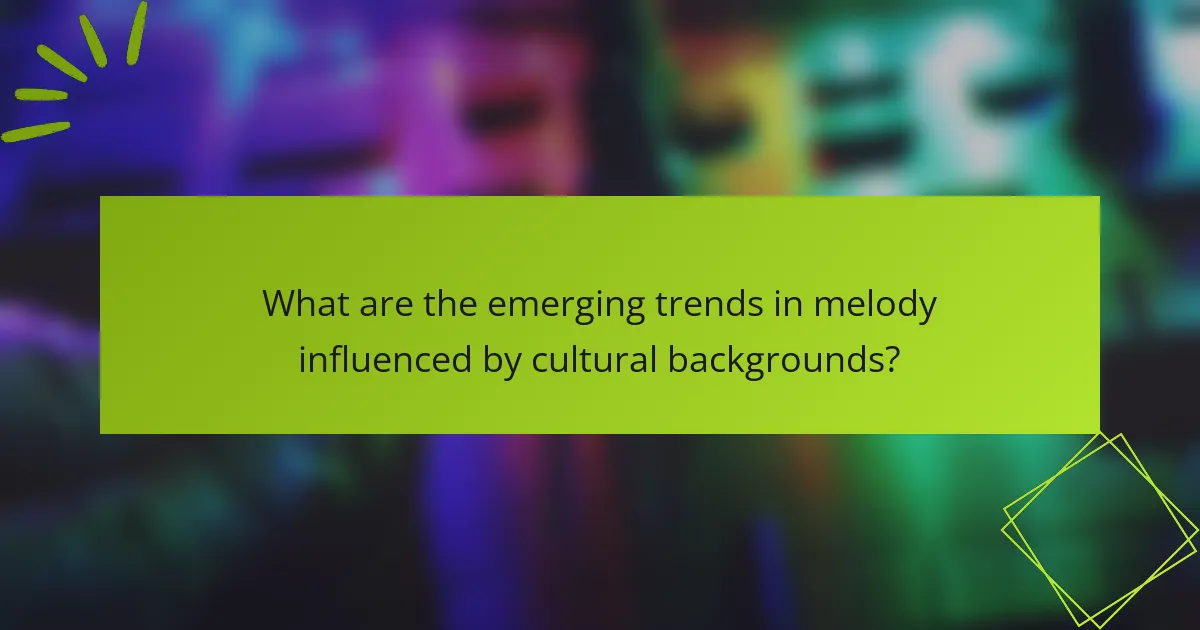
What are the emerging trends in melody influenced by cultural backgrounds?
Emerging trends in melody creation increasingly reflect a blend of diverse cultural backgrounds, resulting in innovative musical expressions. This fusion often leads to unique melodic structures that incorporate traditional elements from various cultures, enhancing the richness of contemporary music.
Global fusion genres
Global fusion genres combine musical styles from different cultural backgrounds, creating fresh and engaging melodies. For instance, genres like Reggaeton blend Latin rhythms with hip-hop, while Afrobeat merges African musical traditions with jazz and funk. These combinations not only diversify the sound but also attract a wider audience.
Artists are experimenting with instruments and scales from various cultures, leading to unique melodic patterns. This trend encourages musicians to explore their roots while embracing global influences, resulting in melodies that resonate with a broader demographic.
Digital platforms for cultural exchange
Digital platforms have revolutionized how musicians share and collaborate across cultural boundaries, significantly influencing melody creation. Services like SoundCloud and YouTube allow artists from different backgrounds to showcase their work, fostering cross-cultural collaborations that enhance melodic diversity.
Social media also plays a crucial role in this exchange, enabling artists to connect and share ideas instantly. This accessibility encourages experimentation with various cultural elements, leading to innovative melodies that reflect a globalized musical landscape.
